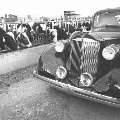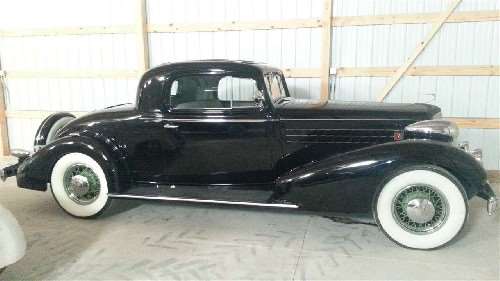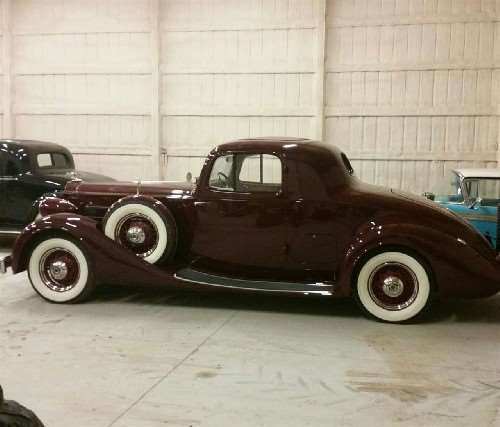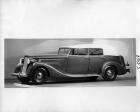|
Re: 1935 - Turning Point and What-Ifs
|
||||
|---|---|---|---|---|
|
Home away from home

|
The original Twin-Six was Jesse Vincent's creation. Why not put an aeroplane type motor in a car? It is uncertain whether a new V-12 to replace the Twin-Six would maintain Packard's position, but the literature claims management was interested in an Eight that would outrun the Twin-Six because it had higher profit margins. At that time the luxury market was already being disseminated and Packard's fat margins were under pressure. A continuation of 12 cylinder cars was seen as a money loser.
Supposedly, one story is the Caddy V-16 was a slap at Henry Ford who was no longer on the then 15 member board of directors at Cadillac. He would have been the 16th member of the Cadillac board - get it? Unfortunately, Packard never again enjoyed the position it had during the period of the Twin-Six. And neither did Rolls-Royce after the Ghost. The engineering department had already grown too complacent.
Posted on: 2015/9/7 8:32
|
|||
|
||||
|
Re: 1935 - Turning Point and What-Ifs
|
||||
|---|---|---|---|---|
|
Home away from home

|
"...mostly wheelbase lengths to reduce the number of frame lengths from eight to six as well as ancillary components required..."
Steve - I totally get what you are suggesting and this would certainly have made Christopher's life easier! For arguments sake I'll take an alternative approach that feeds the consumer's desire for ever greater choice. The Kimes book says Macauley and Christopher had built into the One Twenty line manufacturing flexibility that would allow future changes. I don't know what the One Twenty's biggest cost drivers were but will make an assumption that they had more to do with number of body stampings and unique engine block bore spacings and less with frame, driveshaft, electrical and fluid line lengths. Of course, number of build combinations is always an inventory driver unless just-in-time delivery is used. Not sure how the One Twenty was set up in this regard. Long story short, I added a 5P Coupe and Convertible on unique wheelbase that includes the decklid from Club/Touring Sedan (see earlier post with updated images and pricing table). Packard made such a car for the 12th Series so it is reasonable to assume such a car could have materialized under this 100% One Twenty-based 1935 Packard line-up. It would have been nice had they moved away from the old Victoria-type canvas roof and instead included a side roll-down quarter window. Were they not able to figure out how to make a pillar-less hardtop style, could have used the tried and true removable B-pillar.
Posted on: 2015/9/7 13:51
|
|||
|
||||
|
Re: 1935 - Turning Point and What-Ifs
|
||||
|---|---|---|---|---|
|
Home away from home

|
"...(see earlier post with updated images and pricing table)..."
Also updated the engine specs in the table because kept seeing conflicting CID numbers for the '35 One Twenty's displacement. Had to pull up the 1935 Packard Shop Manual at this site to get it straight. Base V12 displacement now becomes 386 CID.
Posted on: 2015/9/7 14:28
|
|||
|
||||
|
Re: 1935 - Turning Point and What-Ifs
|
||||
|---|---|---|---|---|
|
Home away from home

|
Hi Paul
"I want to make sure I understand what your wheelbase step-ups of 4", 5", 6", 5" and 7" provide in terms of bodies,...." I didn't go as far as the charts to lay it out, just selected the lengths with an eye to minimizing the number of frames to tool, etc. and still have each segment accommodated. They could probably best settle on 5" increments for the wheelbases except for the 7" jump for 145", though that could go to 148" for ease of application. Mixing and matching in five inch longer hoods, doors, quarters for each to get the proper lengths versus that particular models main competitor, therefore: 118", 123", 128", 133", 138" and 148". Eventually, they would delete 118", during a major redesign settle on 123", 130", 137" and 144". If the seven inch leap was too much, throw in a 133.5" for the premium five passenger sedan. No matter how we slice and dice it, a few one-model-only panels would still have to be derived from the major stampings. As long as those were for premium-priced models, it could be absorbed. "With the engines, are you suggesting three V12's and two Eights?" That engine selection came about by the same thought process, i.e. the most bang-for-buck with interchangeable tooling and the fewest blocks . The main engines they would have to compete with were the Cadillac 346ci V8 and 431ci V16, LaSalle 322ci V8, Buick 248 & 320 I8's, and Chrysler 274 & 323 I8's., even the Lincoln-Zephyr 292ci V12 to a degree. Ideally, they'd have developed the 356 ci by 1936, de-stroke it for 320-330 ci range power-plant. The 257 ci and 298 ci on the same block would cover most all the volume models, stretching it to the mid-350 ci range somewhat better, though might not have been possible without a larger bore and attendant tooling expense. A pre-war version of the 288-327-359 ci engines even better to cover the model/price ranges. With the multi-cylinder segment dying elsewhere, a twelve was the opportunity for Packard to differentiate its cars from the others. Eventually one or the other larger displacements, either 385 ci or 423 ci would be generally superfluous. Only the 361 ci twelve would be required for most applications but provide the volume to keep it in production; the 423ci could remain their performance motor. An ongoing V-type engine production should have lead more quickly to the V8 they would need postwar. "Speedsters would have been a natural follow-on to the '34 LeBarons, keeping the excitement going. Sales would not have been high but impact would have been huge. This is where perhaps the coachbuilders could have been of great value, relieving Packard of this low volume manufacturing distraction." Until the Darrins came along, Packard really had no extremely high profile sport models to capture the public's imagination. Sure, the Super Eight and Twelve coupe-roadsters were still seen in the company of the glitterati of the day but nothing iced the cake like a custom LeBaron Speedster. When Darrin arrived in Hollywood and Earle Anthony got wind of it, he should have had an active semi-custom program going there by the '38 model introduction. Darrin had experienced custom body craftsmen working for him, just needed dealer and factory support sooner so his resulting cars weren't so much "cut-'n-paste" customs (thanks to the late Jim Hollingsworth for that description from a brief conversation we had at Warren in '99) More on your responses and further observations shortly. Edit: Added further 9-11-2015 Hi Paul "Your sales data and observations really highlight the huge market changes that Packard found itself swirling around in. I think this all came down to Macauley. What must have been going through his head?" Grappling with an economy turned upside down from the year-after-year enthusiastic acceptance of each new model to one which responded indifferently in spite of putting their best efforts foreword had to exact a toll. One supposes that ongoing mental thrashing rendered by that economy and attendant annual losses, further exacerbated by the hostility of Gilman and Christopher toward the Seniors, his ideal products, had to cause Macauley to become cautious and acquiescent to Gilman's will. But, Alvan was nothing if not pragmatic: the new 120 approach was succeeding, the old failing, why fight it? But here's the curiosity: 1925-29 were their greatest volume sales successes in the entry-level luxury segment lead by these models: Models........Production........Percent of Total Packard Sales by Year 326: ............24,668 cars.........51% of 1925-26 426: ............14,401 cars.........48% of 1927 526: ............28,336 cars.........57% of 1928 626: ........... 26,070 cars.........47% of 1929 Even as the larger six cylinder luxury cars transitioned to the straight eight by the end of the 1920's, still the model specification on which the bulk of success was based stilled defined those of Cadillac Series 60 a decade hence: 126" wb, 320-plus ci engine, predominantly five passenger sedans. By then, the major difference was the entry-level luxury sedan pricing had adjusted down from $2,585 to $1,695. Though obviously based as it was on shared components with lesser makes, it still was fully accepted by the public as the sales indicate. Protest that Packard still offered the 127" wb, five passenger entry-level sedan is quite true, but it was perceived as an updated late 1920's car; not a completely modern automobile yet priced at $2,385, significantly higher than what was accepted as the new base entry-level figure. Why, after being the very individual who had lead the segment in the direction of lower-priced, standard-sized luxury sedans, could Macauley and other principals not conceive of Packard repeating that same success by developing just such a model along with the 120 as an extension of that project? "One thing seems to be sure, Packard's timing for the all-steel bodies in 1938 was inopportune, the company finding itself in a long-term body investment just as GM was changing the benchmark for body proportions. When Darrin said in early 1940 that Packard was scared of GM, this only two years after Packard had made its big investment in all-steel bodies, it was a clear indication that EGB had realized it had gotten its vehicle planning wrong, or at least not quite right. What was Gilman to do? He was fighting GM on one hand and an amortization schedule on the other......." Pushing onto all-steel bodies by 1938 was the correct move, consistent with the industry trend. The downside came with the rapidly evolving styling ethos lead by GM, amortization of the major costs for lower volume producers would become a major challenge. To their credit, when the need for new car with modern body architecture was belatedly recognized i.e. scared to death of GM, they initiated the Clipper project. Of all the independents, only Packard created a completely new car separate from other line-mates. Others, when they did respond to the trend, hedged their bets, still fielded versions of the old touring sedan configuration as well. Although it may seem insignificant now, the integration of a coupe-trunk into a sedan body by 1941 separated what was considered modern from the old-fashioned. Nash and Studebaker included it in their new bodies for 1941, the latter adding a sport/club sedan in their Land Cruisers. Hudson pulled it off too on yet another restyle of their circa-1936 body; Packard did to a degree on the 1938 body but adding few more inches of overhang would have been better. Chrysler, as usual, ginned-up their conservative version of a four-window town sedan, though kept that oddly short trunk. Premium priced over the six-window touring sedan, its sales remained at depressed levels. One wonders why they bothered. Steve
Posted on: 2015/9/7 15:55
|
|||
|
.....epigram time.....
Proud 1953 Clipper Deluxe owner. Thinking about my next Packard, want a Clipper Deluxe Eight, manual shift with overdrive. |
||||
|
||||
|
Re: 1935 - Turning Point and What-Ifs
|
||||
|---|---|---|---|---|
|
Home away from home

|
Hi Steve,
Your point about the 126" wheelbase and 320 CID specs for entry luxury car speak to the fundamental pre-war dynamics at play. In these specs lie the needs and preferences of the owner-driver, a category of buyer that increasingly represented the core of the luxury market. Power, maneuverability, ease of parking and ability to fit in garage were highly valued, along with quality and luxury in a livable package. One of my favorites is the '33 Eight. The 1938 Packard Eight had the right wheelbase and almost enough engine for an entry luxury car but by then the 60 Special had added three new elements that very few cars had offered prior: extra low height, extra wide bodies and a coupe-like trunk. Packard flat-out overlooked these in its planning for 1938 and lost 3-1/2 years to Cadillac because of it. When it finally did catch up, Cadillac once again jumped ahead, this time with an automatic transmission. This cost Packard another 5 model years of not being fully competitive. By the time it did catch up, Cadillac had moved ahead again with the '48 60 Special's extra long rear overhang and decklid and '49 OHV engine. On the former, Packard lost anywhere from 3 to 7 years depending on whether one sees the '51 as sufficient or the '55 Four Hundred. I don't think either were, the Four Hundred having the appearance of long deck but still with the '51s middling overhang. Packard wasn't on track to catch Cadillac in basic vehicle specs until 1957. It's hard to stay in business trailing the competition for 20 years.
Posted on: 2015/9/13 15:31
|
|||
|
||||
|
Re: 1935 - Turning Point and What-Ifs
|
||||
|---|---|---|---|---|
|
Home away from home

|
I don't know much about the turning point in 1935, but having a 1935 packard eight and a 1935 cadillac V8 136" wb (series 20) I can tell you this much:
styling wise the Cadillac looks more speedy with the longer door/ cab and the angled grille. drivingwise I don't think there's any competition! If I had to buy a new packard or cadillac in 1935, I wouldn't even look at a cadillac. The Cadillac is such a hard car to drive, as the Packard handles like a dream compared to the caddy.
Posted on: 2015/9/13 15:53
|
|||
|
I can explain it to you but I can't understand it for you
 Bad company corrupts good character! Farming: the art of losing money while working 100 hours a week to feed people who think you are trying to kill them |
||||
|
||||

 (74.12 KB)
(74.12 KB)








